Grid Synchronization and Islanding Detection Methods for Single-Stage Photovoltaic Systems
Abstract
:1. Introduction
2. Control System Functionalities of a Single-Stage photovoltaic Power System
3. Grid Synchronization
3.1. Zero-Crossing Detection Methods
3.2. PLLs
3.3. EPLLs
4. Islanding Detection
4.1. Communication-Based Methods
4.1.1. PLCC-Based Methods
4.1.2. SCADA-Based Methods
4.2. Passive Methods
4.2.1. OUV and OUF Methods
4.2.2. Phase Jump Method
4.2.3. Rate of Change of Frequency Method
4.2.4. Voltage Harmonic Monitoring Method
4.3. Active Methods
4.3.1. Grid Impedance Variation Methods
4.3.2. Active and Reactive Power Injections Methods
4.3.3. Active Frequency Drift
4.3.4. Sandia Frequency Shift
4.3.5. Sandia Voltage Shift
4.3.6. Slip-Mode Frequency Shift
4.4. Signal Processing-Based Methods
4.4.1. Fourier Transform-Based Methods
4.4.2. Wavelet Transform-Based Methods
4.4.3. S-Transform-Based Methods
4.5. Hybrid Methods
4.6. Performances Evaluation of the Islanding Detection Methods
5. Synchronization and Islanding Detection Coordination
5.1. Impact of the Synchronization Systems on the Islanding Detection Methods
5.2. Reconnection of a PVS to the Grid after an Islanding Event
6. Conclusions
Funding
Conflicts of Interest
References
- IEA PVPS Annual Report 2019. Available online: https://iea-pvps.org/wp-content/uploads/2020/02/5319-iea-pvps-report-2019-08-lr.pdf (accessed on 26 March 2020).
- Solar PV—Statistics & Facts, The Statistics Portal. Available online: https://www.statista.com/topics/993/solar-pv/ (accessed on 15 April 2020).
- International Renewable Energy Agency IRENA. Renewable Capacity Statistics 2020. Available online: https://www.irena.org/publications/2020/Mar/Renewable-Capacity-Statistics-2020 (accessed on 26 March 2020).
- Kausika, B.B.; Moraitis, P.; van Sark, W.G.J.H.M. Visualization of Operational Performance of Grid-Connected PV Systems in Selected European Countries. Energies 2018, 11, 1330. [Google Scholar] [CrossRef] [Green Version]
- Ghosh, S.; Rahman, S. Global deployment of solar photovoltaics: Its opportunities and challenges. In Proceedings of the 2016 IEEE PES Innovative Smart Grid Technologies Conference Europe (ISGT-Europe), Ljubljana, Slovenia, 9–12 October 2016; pp. 1–6. [Google Scholar] [CrossRef]
- Araujo, S.V.; Zacharias, P.; Mallwitz, R. Highly Efficient Single-Phase Transformerless Inverters for Grid-Connected Photovoltaic Systems. IEEE Trans. Ind. Electron. 2010, 57, 3118–3128. [Google Scholar] [CrossRef]
- Olowu, T.O.; Sundararajan, A.; Moghaddami, M.; Sarwat, A.I. Future Challenges and Mitigation Methods for High Photovoltaic Penetration: A Survey. Energies 2018, 11, 1782. [Google Scholar] [CrossRef] [Green Version]
- Integrating Renewable Electricity on the Grid—A Report by the APS Panel on Public Affairs, Washington, DC, USA. Available online: https://www.smartgrid.gov/document/integrating_renewable_electricity_grid_report_aps_panel_public_affairs (accessed on 20 November 2011).
- Ropp, M.; Newmiller, J.; Whitaker, C.; Norris, B. Review of potential problems and utility concerns arising from high penetration levels of photovoltaics in distribution systems. In Proceedings of the 33rd IEEE Photovoltaic Specialists Conference PVSC ’08, San Diego, CA, USA, 11–16 May 2008; pp. 1–6. [Google Scholar] [CrossRef]
- Appen, J.V.; Braun, M.; Stetz, T.; Diwold, K.; Geibel, D. Time in the Sun: The Challenge of High PV Penetration in the German Electric Grid. IEEE Power Energy Mag. 2013, 11, 55–64. [Google Scholar] [CrossRef]
- Molina-García, A.; Mastromauro, R.A.; García-Sánchez, T.; Pugliese, S.; Liserre, M.; Stasi, S. Reactive Power Flow Control for PV Inverters Voltage Support in LV Distribution Networks. IEEE Trans. Smart Grid 2017, 8, 447–456. [Google Scholar] [CrossRef] [Green Version]
- Vasquez, J.C.; Mastromauro, R.A.; Guerrero, J.M.; Liserre, M. Voltage Support Provided by a Droop-Controlled Multifunctional Inverter. IEEE Trans. Ind. Electron. 2009, 56, 4510–4519. [Google Scholar] [CrossRef]
- Mastromauro, R.A.; Liserre, M.; Kerekes, T.; Dell’Aquila, A. A Single-Phase Voltage-Controlled Grid-Connected Photovoltaic System with Power Quality Conditioner Functionality. IEEE Trans. Ind. Electron. 2009, 56, 4436–4444. [Google Scholar] [CrossRef]
- Koutroulis, E.; Blaabjerg, F. Design Optimization of Transformerless Grid-Connected PV Inverters Including Reliability. IEEE Trans. Power Electron. 2013, 28, 325–335. [Google Scholar] [CrossRef]
- Zhang, L.; Sun, K.; Feng, L.; Wu, H.; Xing, Y. A Family of Neutral Point Clamped Full-Bridge Topologies for Transformerless Photovoltaic Grid-Tied Inverters. IEEE Trans. Power Electron. 2013, 28, 730–739. [Google Scholar] [CrossRef]
- Freddy, T.K.S.; Rahim, N.A.; Hew, W.; Che, H.S. Comparison and Analysis of Single-Phase Transformerless Grid-Connected PV Inverters. IEEE Trans. Power Electron. 2014, 29, 5358–5369. [Google Scholar] [CrossRef]
- Yang, Y.; Blaabjerg, F.; Wang, H. Low-Voltage Ride-Through of Single-Phase Transformerless Photovoltaic Inverters. IEEE Trans. Ind. Appl. 2014, 50, 1942–1952. [Google Scholar] [CrossRef] [Green Version]
- Teodorescu, R.; Liserre, M.; Rodriguez, P. Grid Converters for Photovoltaic and Wind Power Systems; IEEE/Wiley: Chichester, UK, 2011. [Google Scholar]
- Mastromauro, R.A.; Liserre, M.; Dell’Aquila, A. Control Issues in Single-Stage Photovoltaic Systems: MPPT, Current and Voltage Control. IEEE Trans. Ind. Inform. 2012, 8, 241–254. [Google Scholar] [CrossRef]
- Johnson, B.B.; Dhople, S.V.; Hamadeh, A.O.; Krein, P.T. Synchronization of Parallel Single-Phase Inverters with Virtual Oscillator Control. IEEE Trans. Power Electron. 2014, 29, 6124–6138. [Google Scholar] [CrossRef]
- Hadjidemetriou, L.; Kyriakides, E.; Yang, Y.; Blaabjerg, F. A Synchronization Method for Single-Phase Grid-Tied Inverters. IEEE Trans. Power Electron. 2016, 31, 2139–2149. [Google Scholar] [CrossRef]
- Shitole, A.B.; Suryawanshi, H.M.; Talapur, G.G.; Sathyan, S.; Ballal, M.S.; Borghate, V.B.; Ramteke, M.R.; Chaudhari, M.A. Grid Interfaced Distributed Generation System with Modified Current Control Loop Using Adaptive Synchronization Technique. IEEE Trans. Ind. Inform. 2017, 13, 2634–2644. [Google Scholar] [CrossRef]
- Nagliero, A.; Mastromauro, R.A.; Liserre, M.; Dell’Aquila, A. Monitoring and Synchronization Techniques for Single-Phase PV Systems. In Proceedings of the 2010 International Symposium on Power Electronics, Electrical Drives, Automation and Motion SPEEDAM 2010, Pisa, Italy, 14–16 June 2010; pp. 1404–1409. [Google Scholar] [CrossRef]
- Ghartemani, M.K.; Iravani, M.R. A nonlinear adaptative filter for online signal analysis in power systems applications. IEEE Trans. Power Deliv. 2002, 17, 617–622. [Google Scholar] [CrossRef]
- IEEE Standard for Interconnection and Interoperability of Distributed Energy Resources with Associated Electric Power Systems Interfaces; IEEE Std 1547-2003; IEEE: Piscataway, NJ, USA, 6 April 2018; pp. 1–138. [CrossRef]
- Anani, N.; AlAli, O.A.-K.; Al-Qutayri, M.; AL-Araji, S. Synchronization of a renewable energy inverter with the grid. J. Renew. Sustain. Energy 2012, 4. [Google Scholar] [CrossRef] [Green Version]
- Lubura, S.; Soja, M.; Lale, S.; Ikić, M. Single-phase phase locked loop with dc offset and noise rejection for photovoltaic inverters. IET Power Electron. 2014, 7, 2288–2299. [Google Scholar] [CrossRef]
- Luna, A.; Rocabert, J.; Candela, J.I.; Hermoso, J.R.; Teodorescu, R.; Blaabjerg, F.; Rodríguez, P. Grid Voltage Synchronization for Distributed Generation Systems Under Grid Fault Conditions. IEEE Trans. Ind. Appl. 2015, 51, 3414–3425. [Google Scholar] [CrossRef]
- Bower, W.; Ropp, M. Evaluation of Islanding Detection Methods for Utility-Interactive Inverters in Photovoltaic Systems. SANDIA REPORT SAND2002-3591. November 2002. Available online: https://pdfs.semanticscholar.org/2a29/ad6772ffef963d7dfdaece6a9db374e5e3b6.pdf (accessed on 29 March 2020).
- Zhou, Y.; Li, H.; Liu, L. Integrated Autonomous Voltage Regulation and Islanding Detection for High Penetration PV Applications. IEEE Trans. Power Electron. 2013, 28, 2826–2841. [Google Scholar] [CrossRef]
- Yang, F.; Xia, N.; Han, Q. Event-Based Networked Islanding Detection for Distributed Solar PV Generation Systems. IEEE Trans. Ind. Inform. 2017, 13, 322–329. [Google Scholar] [CrossRef]
- Baghaee, H.R.; Mlakić, D.; Nikolovski, S.; Dragicčvić, T. Anti-Islanding Protection of PV-Based Microgrids Consisting of PHEVs Using SVMs. IEEE Trans. Smart Grid 2020, 11, 483–500. [Google Scholar] [CrossRef]
- Reddy, V.R.; Sreeraj, S.E. A Feedback-Based Passive Islanding Detection Technique for One-Cycle-Controlled Single-Phase Inverter Used in Photovoltaic Systems. IEEE Trans. Ind. Electron. 2020, 67, 6541–6549. [Google Scholar] [CrossRef]
- Hung, G.-K.; Chang, C.-C.; Chen, C.-L. Automatic phase-shift method for islanding detection of grid-connected photovoltaic inverters. IEEE Trans. Energy Convers. 2003, 18, 169–173. [Google Scholar] [CrossRef]
- Serban, E.; Serban, H. A Control Strategy for a Distributed Power Generation Microgrid Application with Voltage- and Current-Controlled Source Converter. IEEE Trans. Power Electron. 2010, 25, 2981–2992. [Google Scholar] [CrossRef] [Green Version]
- IEEE Application Guide for IEEE Std 1547™, IEEE Standard for Interconnecting Distributed Resources with Electric Power Systems; IEEE: Piscataway, NJ, USA, April 2009; pp. 1–217. [CrossRef]
- IEEE Approved Draft Standard Conformance Test Procedures for Equipment Interconnecting Distributed Energy Resources with Electric Power Systems and Associated Interfaces; IEEE P1547.1/D9.9; IEEE: Piscataway, NJ, USA, January 2020; pp. 1–283.
- IEEE Recommended Practice for Utility Interface of Photovoltaic (PV) Systems; IEEE Std 929-2000; IEEE: New York, NY, USA, 2000. [CrossRef]
- IEC 61727-2004. Photovoltaic (PV) Systems—Characteristics of the Utility Interface; International Electrotechnical Commission: Geneva, Switzerland, 2004. [Google Scholar]
- GB/T 19939-2005. Technical Requirements for Grid Connection of PV System; China National Standardization Administration Committee: Beijing, China, 2005. [Google Scholar]
- CIGRE Working Group B5. The Impact of Renewable Energy Sources and Distributed Generation on Substation Protection and Automation; CIGRE: Paris, France, 2010. [Google Scholar]
- Gardner, F.M. Phaselock Techniques, 2nd ed.; Wiley-Interscience: Hoboken, NJ, USA, 1979; p. 304. ISBN -10: 0471042943. [Google Scholar]
- Jaalam, N.; Rahim, N.A.; Bakar, A.H.A.; Tan, C.; Haidar, A.M.A. A comprehensive review of synchronization methods for grid-connected converters of renewable energy source. Renew. Sustain. Energy Rev. 2016, 59, 1471–1481. [Google Scholar] [CrossRef] [Green Version]
- Guan-Chyun, H.; Hung, J.C. Phase-locked loop techniques. A Survey. IEEE Trans. Ind. Electron. 1996, 43, 609–615. [Google Scholar] [CrossRef]
- Golestan, S.; Guerrero, J.M.; Vasquez, J.C. Three-Phase PLLs: A Review of Recent Advances. IEEE Trans. Power Electron. 2017, 32, 1894–1907. [Google Scholar] [CrossRef] [Green Version]
- Golestan, S.; Monfared, M.; Freijedo, F. Design-oriented study of advanced synchronous reference frame phase-locked loops. IEEE Trans. Power Electron. 2013, 28, 765–778. [Google Scholar] [CrossRef]
- Paiva, S.C.; Sanca, H.S.; Costa, F.B.; Souza, B.A. Reviewing of anti-islanding protection. In Proceedings of the 11th IEEE/IAS International Conference on Industry Applications, Juiz de Fora, Brazil, 7–10 December 2014; pp. 1–8. [Google Scholar] [CrossRef]
- Li, C.; Cao, C.; Cao, Y.; Kuang, Y.; Zeng, L.; Fang, B. A review of islanding detection methods for microgrid. Renew. Sustain. Energy Rev. 2014, 35, 211–220. [Google Scholar] [CrossRef]
- de Mango, F.; Liserre, M.; Dell’Aquila, A.; Pigazo, A. Overview of anti-islanding algorithms for PV systems. Part I: Passive methods. In Proceedings of the 12th International Power Electronics and Motion Conference, Portoroz, Slovenia, 30 August–1 September 2006; pp. 1878–1883. [Google Scholar] [CrossRef]
- de Mango, F.; Liserre, M.; Dell’Aquila, A. Overview of anti-islanding algorithms for PV systems. Part II: Active methods. In Proceedings of the 12th International Power Electronics and Motion Conference, Portoroz, Slovenia, 30 August 30–1 September 2006; pp. 1884–1889. [Google Scholar] [CrossRef]
- Abokhalil, A.G.; Awan, A.B.; Al-Qawasmi, A.R. Comparative Study of Passive and Active Islanding Detection Methods for PV Grid-Connected Systems. Sustainability 2018, 10, 1798. [Google Scholar] [CrossRef] [Green Version]
- Mahat, P.; Chen, Z.; Bak-Jensen, B. Review of islanding detection methods for distributed generation. In Proceedings of the Third International Conference on Electric Utility Deregulation and Restructuring and Power Technologies, Nanjing, China, 6–8 April 2008; pp. 2743–2748. [Google Scholar] [CrossRef]
- Estébanez, E.J.; Moreno, V.M.; Pigazo, A.; Liserre, M.; Dell’Aquila, A. Performance Evaluation of Active Islanding-Detection Algorithms in Distributed-Generation Photovoltaic Systems: Two Inverters Case. IEEE Trans. Ind. Electron. 2011, 58, 1185–1193. [Google Scholar] [CrossRef] [Green Version]
- Trujillo, C.L.; Velasco, D.; Figueres, E.; Garcerá, G. Analysis of active islanding detection methods for grid-connected microinverters for renewable energy processing. Appl. Energy 2010, 87, 3591–3605. [Google Scholar] [CrossRef] [Green Version]
- Raza, S.; Mokhlis, H.; Arof, H.; Laghari, J.A.; Wang, L. Application of signal processing techniques for islanding detection of distributed generation in distribution network: A review. Energy Convers. Manag. 2015, 96, 613–624. [Google Scholar] [CrossRef] [Green Version]
- Manikonda, S.K.G.; Gaonkar, D.N. Comprehensive review of IDMs in DG systems. IET Smart Grid 2019, 2, 11–24. [Google Scholar] [CrossRef]
- Khamis, A.; Shareef, H.; Bizkevelci, E.; Khatib, T. A review of islanding detection techniques for renewable distributed generation systems. Renew. Sustain. Energy Rev. 2013, 28, 483–493. [Google Scholar] [CrossRef]
- Singh, S.; Kewat, S.; Singh, B.; Panigrahi, B.K.; Kushwaha, M.K. Seamless Control of Solar PV Grid Interfaced System with Islanding Operation. IEEE Power Energy Technol. Syst. J. 2019, 6, 162–171. [Google Scholar] [CrossRef]
- Lee, K.J.; Lee, J.P.; Shin, D.; Yoo, D.W.; Kim, H.J. A novel grid synchronization pll method based on adaptive low-pass notch filter for grid-connected pcs. IEEE Trans. Ind. Electron. 2014, 61, 292–301. [Google Scholar] [CrossRef]
- Wang, Y.F.; Li, Y.W. A Grid Fundamental and Harmonic Component Detection Method for Single-Phase Systems. IEEE Trans. Power Electron. 2013, 28, 2204–2213. [Google Scholar] [CrossRef]
- Karimi-Ghartemani, M. A Unifying Approach to Single-Phase Synchronous Reference Frame PLLs. IEEE Trans. Power Electron. 2013, 28, 4550–4556. [Google Scholar] [CrossRef]
- Wall, R.W. Simple methods for detecting zero crossing. In Proceedings of the 29th Annual Conference of the IEEE Industrial Electronics Society IECON’03, Roanoke, VA, USA, 2–6 November 2003; Volume 3, pp. 2477–2481. [Google Scholar] [CrossRef]
- Golestan, S.; Monfared, M.; Freijedo, F.D.; Guerrero, J.M. Dynamics Assessment of Advanced Single-Phase PLL Structures. IEEE Trans. Ind. Electron. 2013, 60, 2167–2177. [Google Scholar] [CrossRef]
- Kandeepan, S.; Reisenfeld, S. Frequency tracking and acquisition with a four-quadrant arctan phase detector based digital phase locked loop. In Proceedings of the 2003 Joint Fourth International Conference on Information, Communications and Signal Processing and the Fourth Pacific Rim Conference on Multimedia, Singapore, 15–18 December 2003; Volume 1, pp. 401–405. [Google Scholar] [CrossRef]
- Konara, K.M.S.Y.; Kolhe, M.L.; Sankalpa, W.G.C.A. Grid synchronization of DC energy storage using Voltage Source Inverter with ZCD and PLL techniques. In Proceedings of the 2015 IEEE 10th International Conference on Industrial and Information Systems (ICIIS), Peradeniya, Sri Lanka, 18–20 December 2015; pp. 458–462. [Google Scholar] [CrossRef]
- Weidenbrug, R.; Dawson, F.P.; Bonert, R. New synchronization method for thyristor power converters to weak AC-systems. IEEE Trans. Ind. Electron. 1993, 40, 505–511. [Google Scholar] [CrossRef]
- Mur, F.; Cardenas, V.; Vaquero, J.; Martinez, S. Phase synchronization and measurement digital systems of AC mains for power converters. In Proceedings of the 6th IEEE Power Electronics Congress CIEP 98, Morelia, Mexico, 12–15 October 1998; pp. 188–194. [Google Scholar] [CrossRef]
- Choi, J.-W.; Kim, Y.-K.; Kim, H.-G. Digital PLL control for single-phase photovoltaic system. IEE Proc. EE Electr. Power Appl. 2006, 153, 40–46. [Google Scholar] [CrossRef]
- Gonzalez-Espin, F.; Figueres, E.; Garcera, G. An Adaptive Synchronous-Reference-Frame Phase-Locked Loop for Power Quality Improvement in a Polluted Utility Grid. IEEE Trans. Ind. Electron 2012, 59, 2718–2731. [Google Scholar] [CrossRef] [Green Version]
- Yazdani, D.; Bakhshai, A.; Jain, P. Grid synchronization techniques for converter interfaced distributed generation systems. In Proceedings of the 2009 Energy Conversion Congress and Exposition, ECCE 2009, San Jose, CA, USA, 20–24 September 2009; pp. 2007–2014. [Google Scholar] [CrossRef]
- Han, Y.; Luo, M.; Zhao, X.; Guerrero, J.M.; Xu, L. Comparative Performance Evaluation of Orthogonal-Signal-Generators-Based Single-Phase PLL Algorithms—A Survey. IEEE Trans. Power Electron. 2016, 31, 3932–3944. [Google Scholar] [CrossRef] [Green Version]
- Yang, Y.; Blaabjerg, F.; Zou, Z. Benchmarking of Grid Fault Modes in Single-Phase Grid-Connected Photovoltaic Systems. IEEE Trans. Ind. Appl. 2013, 49, 2167–2176. [Google Scholar] [CrossRef]
- Rodriguez, P.; Teodorescu, R.; Candela, I.; Timbus, A.V.; Laabjerg, F.B. New positive-sequence voltage detector for grid synchronization of power converters under faulty grid conditions. In Proceedings of the 2006 37th IEEE Power Electronics Specialists Conference PESC’06, Jeju, Korea, 18–22 June 2006; pp. 1–7. [Google Scholar] [CrossRef]
- Chittora, P.; Singh, A.; Singh, M. Adaptive EPLL for improving power quality in three-phase three-wire grid-connected photovoltaic system. IET Renew. Power Gener. 2019, 13, 1595–1602. [Google Scholar] [CrossRef]
- Karimi-Ghartemani, M. Enhanced Phase-Locked Loop Structures for Power and Energy Applications; Wiley-IEEE Press: Piscataway, NJ, USA, 21 March 2014. [Google Scholar] [CrossRef]
- Karimi-Ghartemani, M. Linear and Pseudolinear Enhanced Phased-Locked Loop (EPLL) Structures. IEEE Trans. Ind. Electron. 2014, 61, 1464–1474. [Google Scholar] [CrossRef]
- Sahoo, A.; Mahmud, K.; Ciobotaru, M.; Ravishankar, J. Adaptive Grid Synchronization Technique for Single-phase Inverters in AC Microgrid. In Proceedings of the 2019 IEEE Energy Conversion Congress and Exposition (ECCE), Baltimore, MD, USA, 29 September–3 October 2019; pp. 4441–4446. [Google Scholar] [CrossRef]
- Task V Report IEA-PVPS T5-09:2002, Evaluation of Islanding Detection Methods for Photovoltaic Utility-Interactive Power Systems. Available online: https://iea-pvps.org/wp-content/uploads/2020/01/rep5_09.pdf (accessed on 15 December 2002).
- Ye, Z.; Kolwalkar, A.; Zhang, Y.; Du, P.; Walling, R. Evaluation of anti-islanding schemes based on nondetection zone concept. IEEE Trans. Power Electron. 2004, 19, 1171–1176. [Google Scholar] [CrossRef]
- Ropp, M.E.; Begovic, M.; Rohatgi, A.; Kern, G.A.; Bonn, R.H.; Gonzalez, S. Determining the relative effectiveness of islanding detection methods using phase criteria and nondetection zones. IEEE Trans. Energy Convers. 2000, 15, 290–296. [Google Scholar] [CrossRef]
- IEEE Standard for Interconnecting Distributed Resources with Electric Power Systems; IEEE Std 1547-2003; IEEE: Piscataway, NJ, USA, 1–28 July 2003. [CrossRef]
- Shrestha, A.; Kattel, R.; Dachhepatic, M.; Mali, B.; Thapa, R.; Singh, A.; Bista, D.; Adhikary, B.; Papadakis, A.; Maskey, R.K. Comparative Study of Different Approaches for Islanding Detection of Distributed Generation Systems. Appl. Syst. Innov. 2019, 2. [Google Scholar] [CrossRef] [Green Version]
- Samuelsson, O.; Strath, N. Islanding detection and connection requirements. In Proceedings of the 2007 IEEE Power Engineering Society General Meeting, Tampa, FL, USA, 24–28 June 2007; pp. 1–6. [Google Scholar] [CrossRef]
- Ropp, M.; Larson, D.; Meendering, S.; MacMahon, D.; Ginn, J.; Stevens, J.; Bower, W.; Gonzalez, S.; Fennell, K.; Brusseau, L. Discussion of power line carrier communications-based anti-islanding scheme using a commercial automatic meter reading system. In Proceedings of the 4th IEEE World Conference on Photovoltaic Energy Conversion, Waikoloa, HI, USA, 7–12 May 2006; pp. 2351–2354. [Google Scholar] [CrossRef]
- Benato, R.; Caldon, R. Distribution line carrier: Analysis procedure and applications to DG. IEEE Trans. Power Deliv. 2007, 22, 575–583. [Google Scholar] [CrossRef]
- Xu, W.; Zhang, G.; Li, C.; Wang, W.; Wang, G.; Kliber, J. A power line signaling based technique for anti-islanding protection of distributed generators—Part i: Scheme and analysis. IEEE Trans. Power Deliv. 2007, 22, 1758–1766. [Google Scholar] [CrossRef]
- Wang, G.; Kliber, J.; Zhang, G.; Xu, W.; Howell, B.; Palladino, T. A power line signaling based technique for anti-islanding protection of distributed generators—Part ii: Field test results. IEEE Trans. Power Deliv. 2007, 22, 1767–1772. [Google Scholar] [CrossRef]
- Aphrodis, N.; Ntagwirumugara, E.; Vianney, B.J.M.; Mulolani, F. Design, Control and Validation of a PV System Based on Supervisory Control and Data Acquisition (SCADA) Viewer in Smartgrids. In Proceedings of the 5th International Conference on Control, Automation and Robotics (ICCAR), Beijing, China, 19–22 April 2019; pp. 23–28. [Google Scholar] [CrossRef]
- Etxegarai, A.; Egua, P.; Zamora, I. Analysis of remote islanding detection methods for distributed resources. In Proceedings of the International Conference on Renewable Energies and Power Quality (ICREPQ’11), Las Palmas, Spain, 13–15 April 2011; pp. 1142–1147. Available online: http://www.icrepq.com/icrepq’11/580-etxegarai.pdf (accessed on 29 March 2020).
- Vieira, W.X.J.C.; Freitas, W.; Morelato, A. Performance of frequency relays for distributed generation protection. IEEE Trans. Power Deliv. 2006, 21, 1120–1127. [Google Scholar] [CrossRef]
- Freitas, W.; Xu, W.; Affonso, C.M.; Huang, Z. Comparative analysis between ROCOF and vector surge relays for distributed generation applications. IEEE Trans. Power Deliv. 2005, 20, 1315–1324. [Google Scholar] [CrossRef]
- Ten, C.F.; Crossley, P.A. Evaluation of Rocof Relay Performances on Networks with Distributed Generation. In Proceedings of the 2008 IET 9th International Conference on Developments in Power System Protection (DPSP 2008), Glasgow, Scotland, 17–20 March 2008; pp. 523–528. [Google Scholar] [CrossRef]
- de la Fuente, D.V.; Rodriguez, C.L.T.; Narvaez, E.A. Review of Anti-Islanding Methods: Analysis by Figures of Merit Tools for Controllers Reconfiguration in Microgrids. IEEE Lat. Am. Trans. 2015, 13, 679–686. [Google Scholar] [CrossRef]
- Timbus, A.V.; Teodorescu, R.; Blaabjerg, F.; Borup, U. Online grid measurement and ENS detection for PV inverter running on highly inductive grid. IEEE Power Electron. Lett. 2004, 2, 77–82. [Google Scholar] [CrossRef]
- Asiminoaei, L.; Teodorescu, R.; Blaabjerg, F.; Borup, U. A digital controlled PV-inverter with grid impedance estimation for ENS detection. IEEE Trans. Power Electron. 2005, 20, 1480–1490. [Google Scholar] [CrossRef]
- Jeraputra, P.N. Enjeti, Development of a robust anti-islanding algorithm for utility interconnection of distributed fuel cell powered generation. IEEE Trans. Power Electron. 2004, 19, 1163–1170. [Google Scholar] [CrossRef]
- Du, P.; Ye, Z.; Aponte, E.E.; Nelson, J.K.; Fan, L. Positive-Feedback-Based Active Anti-Islanding Schemes for Inverter-Based Distributed Generators: Basic Principle, Design Guideline and Performance Analysis. IEEE Trans. Power Electron. 2010, 25, 2941–2948. [Google Scholar] [CrossRef]
- Zeineldin, H.H.; Conti, S. Sandia frequency shift parameter selection for multi-inverter systems to eliminate non-detection zone. IET Renew. Power Gener. 2011, 5, 175–183. [Google Scholar] [CrossRef]
- Reis, M.V.G.; Barros, T.A.S.; Moreira, A.B.; Nascimento, S.F.P.; Ruppert, F.E.; Villalva, M.G. Analysis of the Sandia Frequency Shift (SFS) islanding detection method with a single-phase photovoltaic distributed generation system. In Proceedings of the 2015 IEEE PES Innovative Smart Grid Technologies Latin America ISGT LATAM 2015, Montevideo, Uruguay, 5–7 October 2015; pp. 125–129. [Google Scholar] [CrossRef]
- El-Moubarak, M.; Hassan, M.; Faza, A. Performance of three islanding detection methods for grid-tied multi-inverters. In Proceedings of the 2015 IEEE 15th International Conference on Environment and Electrical Engineering (EEEIC), Rome, Italy, 10–13 June 2015; pp. 1999–2004. [Google Scholar] [CrossRef]
- Mohammadpour, B.; Zareie, M.; Eren, S.; Pahlevani, M. Stability analysis of the slip mode frequency shift islanding detection in single phase PV inverters. In Proceedings of the 2017 IEEE 26th International Symposium on Industrial Electronics (ISIE), Edinburgh, UK, 19–21 June 2017; pp. 873–878. [Google Scholar] [CrossRef]
- Mohammadpour, B.; Pahlevani, M.; Kaviri, S.M.; Jain, P. Advanced slip mode frequency shift islanding detection method for single phase grid connected PV inverters. In Proceedings of the 2016 IEEE Applied Power Electronics Conference and Exposition (APEC), Long Beach, CA, USA, 20–24 March 2016; pp. 378–385. [Google Scholar] [CrossRef]
- Gu, Y.H.; Bollen, M.H.J. Time-Frequency and Time-Scale Domain Analysis of Voltage Disturbances. IEEE Trans. Power Deliv. 2000, 15, 1279–1284. [Google Scholar] [CrossRef]
- Kim, I.-S. Islanding Detection Technique using Grid-Harmonic Parameters in the Photovoltaic System. Energy Procedia 2012, 14, 137–141. [Google Scholar] [CrossRef] [Green Version]
- Kim, J.; Kim, J.; Ji, Y.; Jung, Y.; Won, C. An Islanding Detection Method for a Grid-Connected System Based on the Goertzel Algorithm. IEEE Trans. Power Electron. 2011, 26, 1049–1055. [Google Scholar] [CrossRef]
- Hanif, M.; Basu, M.; Gaughan, K. Development of EN50438 compliant wavelet-based islanding detection technique for three-phase static distributed generation systems. IET Renew. Power Gener. 2012, 6, 289–301. [Google Scholar] [CrossRef]
- Zhu, Y.; Yang, Q.; Wu, J.; Zheng, D.; Tian, Y. A novel islanding detection method of distributed generator based on wavelet transform. In Proceedings of the 2008 International Conference on Electrical Machines and Systems, Wuhan, China, 17–20 October 2008; pp. 2686–2688. [Google Scholar]
- Ning, J.; Wang, C. Feature extraction for islanding detection using Wavelet Transform-based Multi-Resolution Analysis. In Proceedings of the 2012 IEEE Power and Energy Society General Meeting, San Diego, CA, USA, 22–26 July 2012; pp. 1–6. [Google Scholar] [CrossRef]
- Hsieh, C.-T.; Lin, J.-M.; Huang, S.-J. Enhancement of islanding-detection of distributed generation systems via wavelet transform-based approaches. Int. J. Electr. Power Energy Syst. 2008, 30, 575–580. [Google Scholar] [CrossRef]
- Do, H.T.; Zhang, X.; Nguyen, N.V.; Li, S.S.; Chu, T.T. Passive-Islanding Detection Method Using the Wavelet Packet Transform in Grid-Connected Photovoltaic Systems. IEEE Trans. Power Electron. 2016, 31, 6955–6967. [Google Scholar] [CrossRef]
- Pigazo, A.; Liserre, M.; Mastromauro, R.A.; Moreno, V.M.; Dell’Aquila, A. Wavelet-Based Islanding Detection in Grid-Connected PV Systems. IEEE Trans. Ind. Electron. 2009, 56, 4445–4455. [Google Scholar] [CrossRef] [Green Version]
- Ray, P.; Mohanty, S.; Kishor, S.; Dubey, H. Coherency determination in grid connected distributed generation based hybrid system under islanding scenarios. In Proceedings of the IEEE International Conference on Power and Energy (PECon2010), Kuala Lumpur, Malaysia, 29 November–1 December 2010; pp. 85–88. [Google Scholar] [CrossRef]
- Ray, P.; Kishor, N.; Mohanty, S. S-Transform based islanding detection in grid connected distributed generation based power system. In Proceedings of the 2010 IEEE International Energy Conference (ENERGYCON2010), Manama, Bahrain, 18–22 December 2010; pp. 612–617. [Google Scholar] [CrossRef]
- Ray, P.; Mohanty, S.; Kishor, N. Disturbance detection in grid-connected distributed generation system using wavelet and S-Transform. Electr. Power Syst. Res. 2011, 81, 805–819. [Google Scholar] [CrossRef]
- Quoc-Tuan, T. New methods of islanding detection for photovoltaic inverters. In Proceedings of the 2016 IEEE PES Innovative Smart Grid Technologies Conference Europe (ISGT-Europe), Ljubljana, Slovenia, 9–12 October 2016; pp. 1–5. [Google Scholar] [CrossRef]
- Liu, S.; Zhuang, S.; Xu, Q.; Xiao, J. Improved voltage shift islanding detection method for multi-inverter grid-connected photovoltaic systems. IET Gener. Transm. Distrib. 2016, 10, 3163–3169. [Google Scholar] [CrossRef]
- Dhar, S.; Dash, P.K. Harmonic Profile Injection-Based Hybrid Active Islanding Detection Technique for PV-VSC-Based Microgrid System. IEEE Trans. Sustain. Energy 2016, 7, 1473–1481. [Google Scholar] [CrossRef]
- Yu, B.; Matsui, M.; So, J.; Yu, G. A high power quality anti-islanding method using effective power variation. Sol. Energy 2008, 82, 368–378. [Google Scholar] [CrossRef]
- Yu, B.; Matsui, M.; Jung, Y.; Yu, G. A combined active anti-islanding method for photovoltaic systems. Renew. Energy 2008, 33, 979–985. [Google Scholar] [CrossRef]
- Muñoz-Cruzado-Alba, J.; Villegas-Núñez, J.; Vite-Frías, J.A.; Carrasco-Solís, J.M.; Galván-Díez, E. New Low-Distortion Q–f Droop Plus Correlation Anti-Islanding Detection Method for Power Converters in Distributed Generation Systems. IEEE Trans. Ind. Electron. 2015, 62, 5072–5081. [Google Scholar] [CrossRef]
- Papadimitriou, C.N.; Kleftakis, V.A.; Hatziargyriou, N.D. A novel islanding detection method for microgrids based on variable impedance insertion. Electr. Power Syst. Res. 2015, 121, 58–66. [Google Scholar] [CrossRef]
- Vyas, S.; Kumar, R. Computational geometry-based methodology for identification of potential islanding initiators in high solar PV penetration distribution feeders. IET Renew. Power Gener. 2018, 12, 456–462. [Google Scholar] [CrossRef]
- Voglitsis, D.; Papanikolaou, N.P.; Kyritsis, A.C. Active Cross-Correlation Anti-Islanding Scheme for PV Module-Integrated Converters in the Prospect of High Penetration Levels and Weak Grid Conditions. IEEE Trans. Power Electron. 2019, 34, 2258–2274. [Google Scholar] [CrossRef]
- Baghaee, H.R.; Mlakić, D.; Nikolovski, S.; Dragičević, T. Support Vector Machine-based Islanding and Grid Fault Detection in Active Distribution Networks. IEEE J. Emerg. Sel. Top. Power Electron. 2019. [Google Scholar] [CrossRef]
- Eshraghi, A.; Ghorbani, R. Islanding detection and over voltage mitigation using controllable loads. Sustain. Energy Grids Netw. 2016, 6, 125–135. [Google Scholar] [CrossRef]
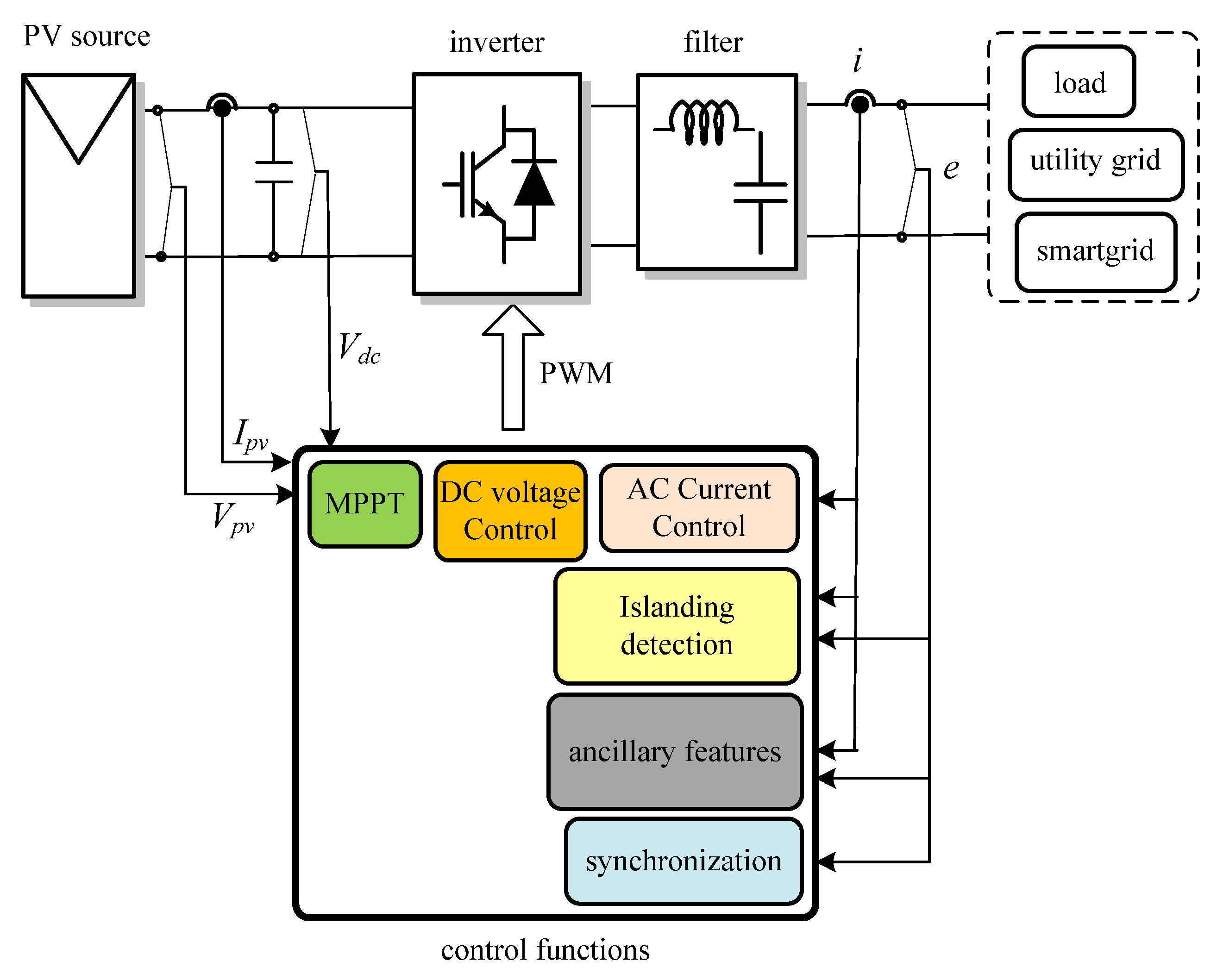
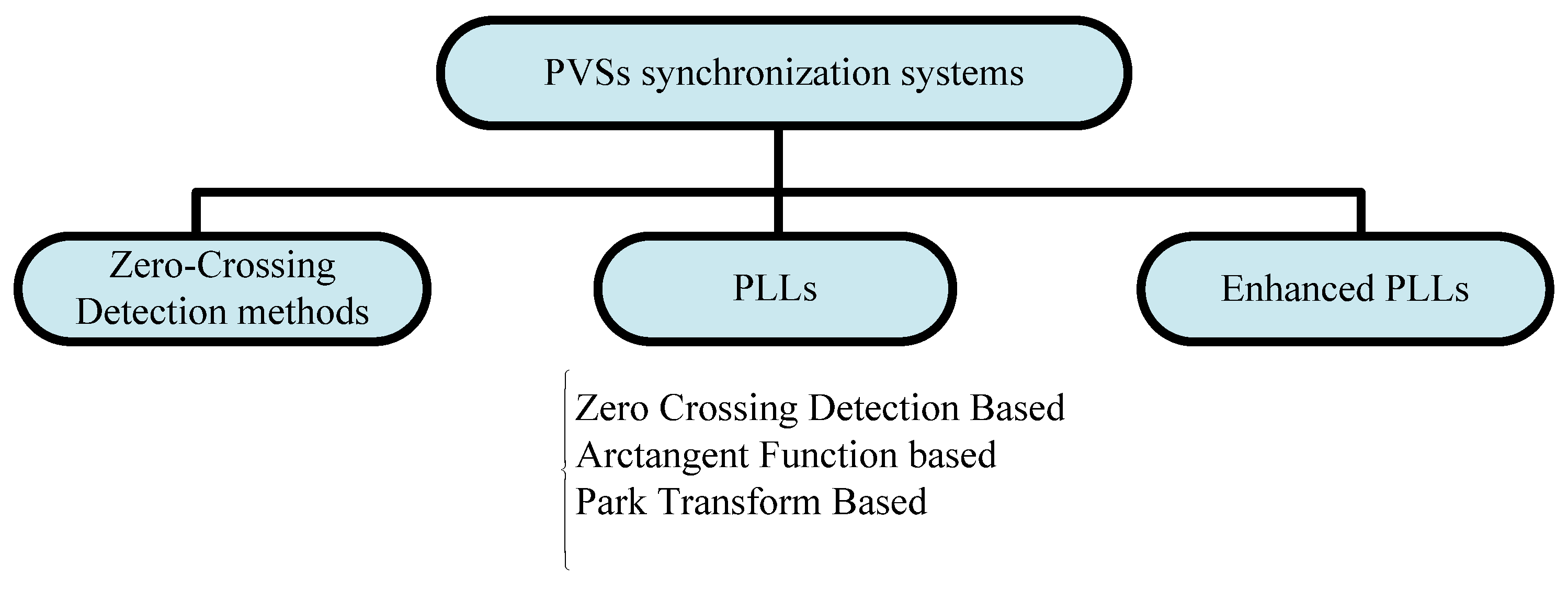
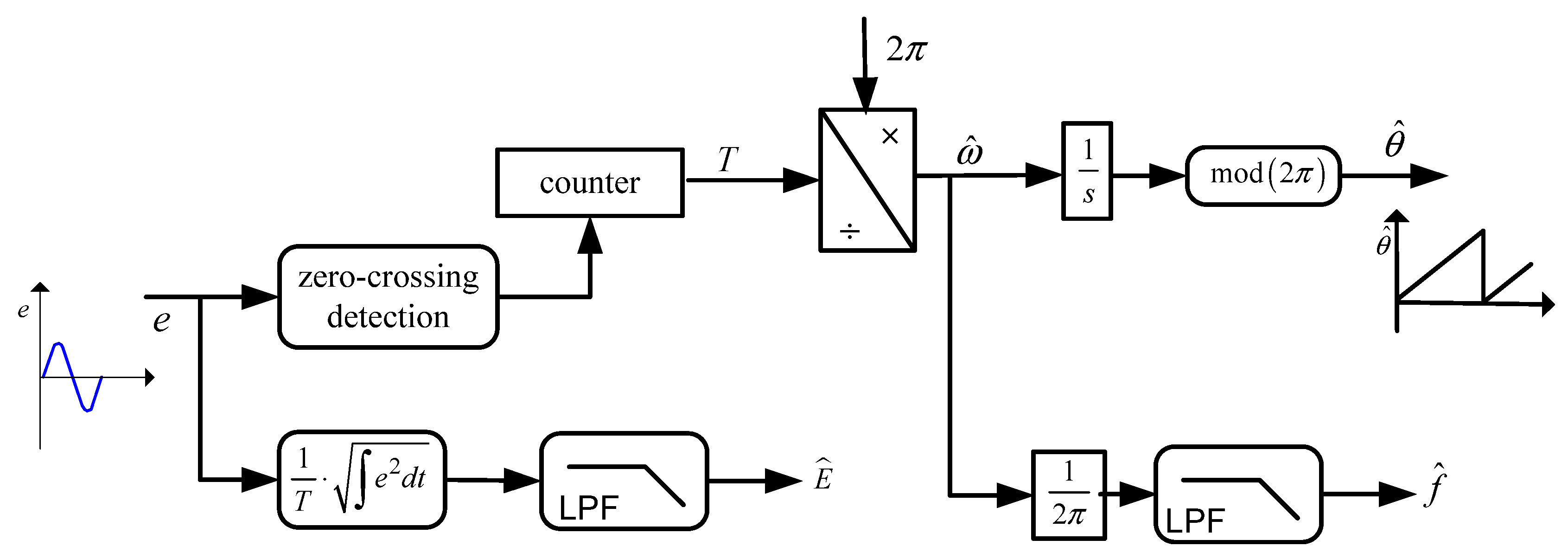

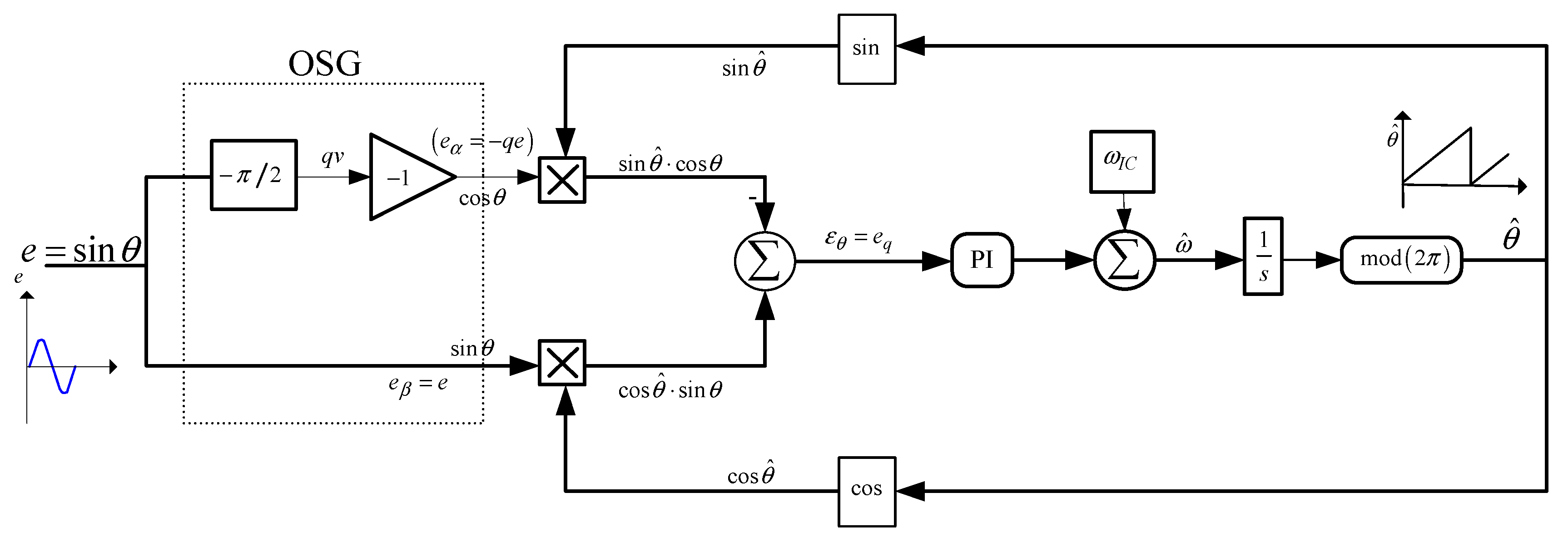
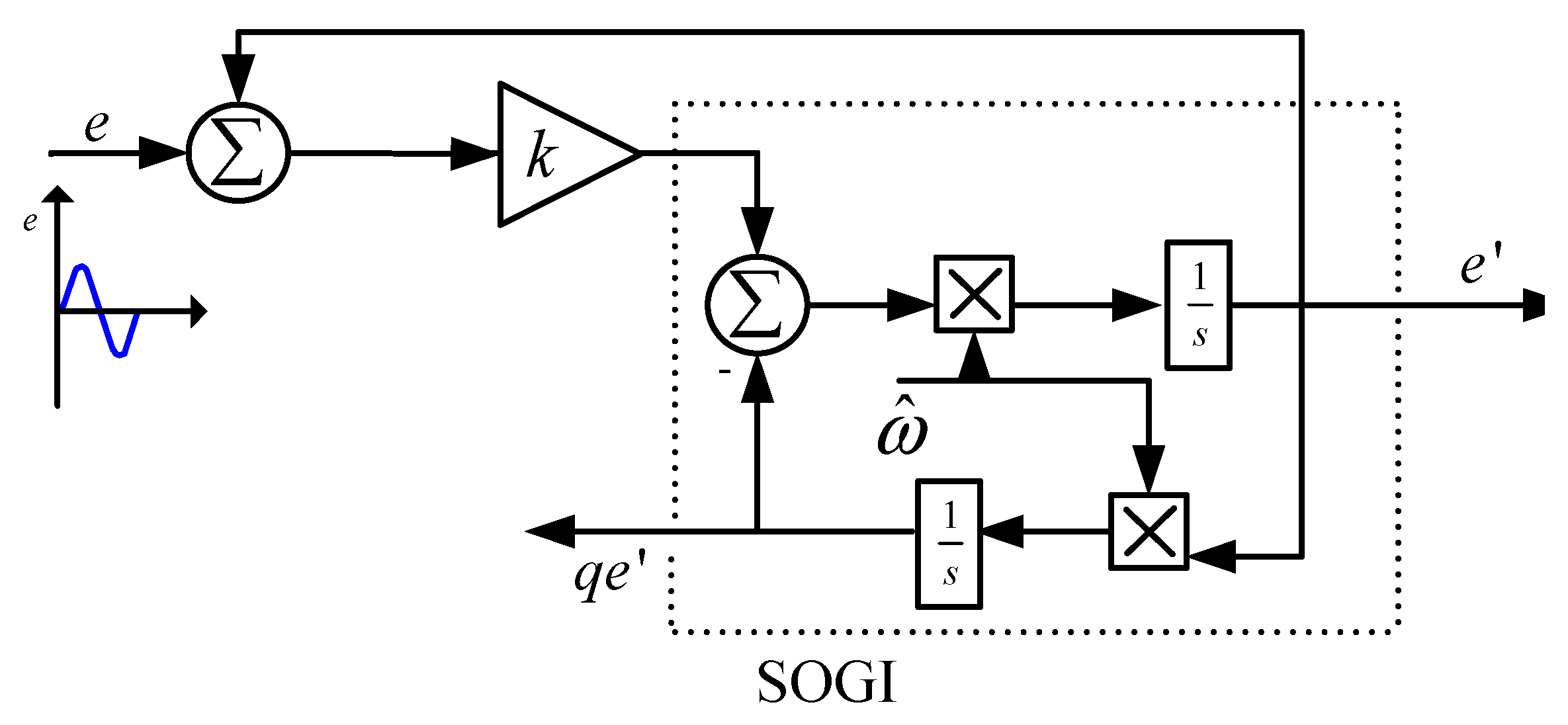
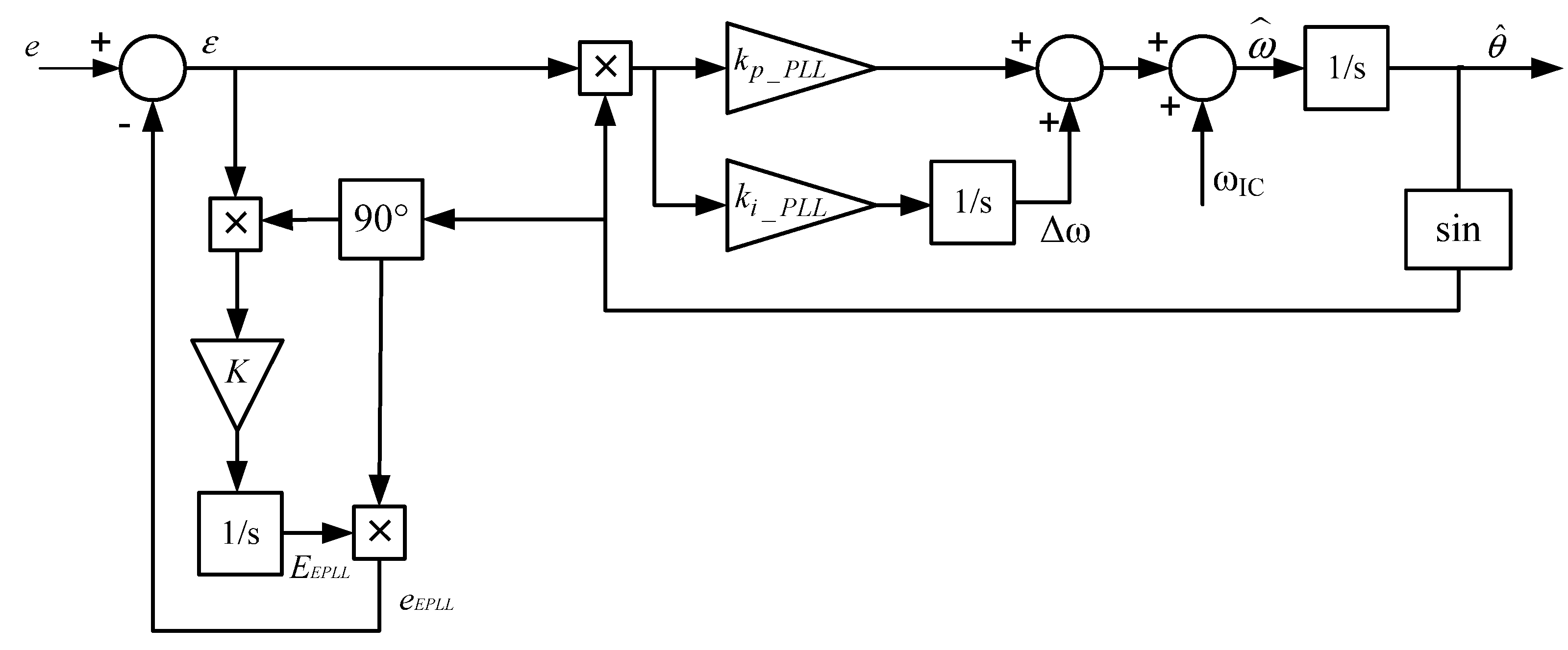
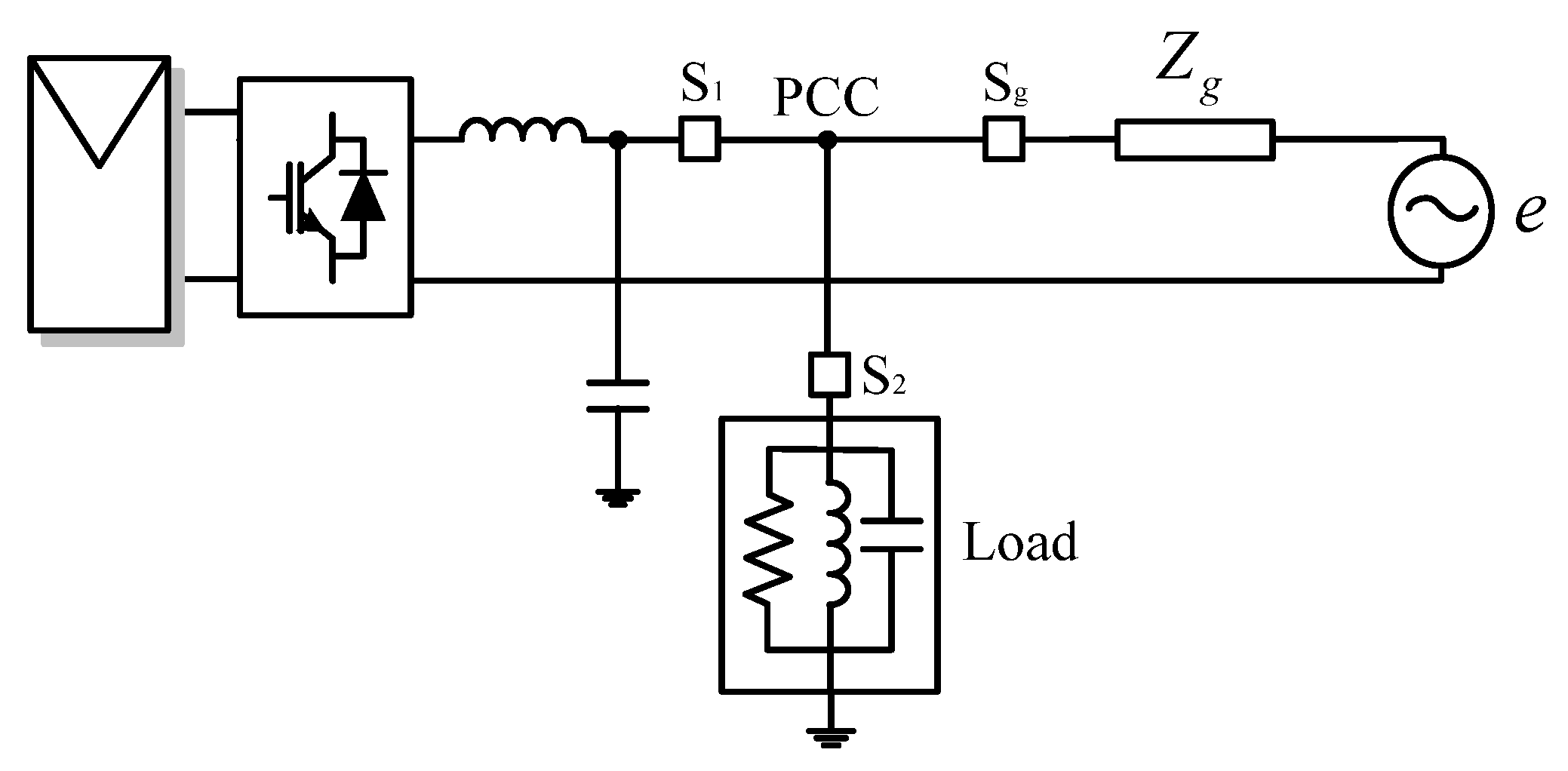

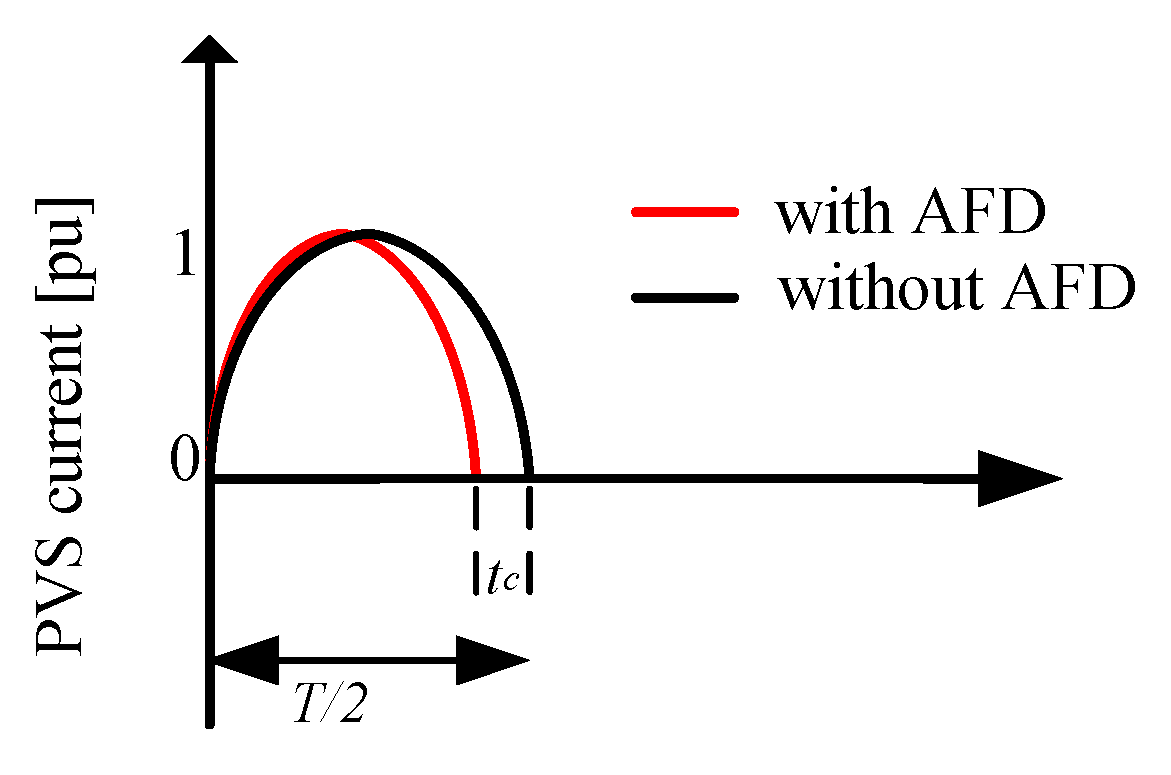

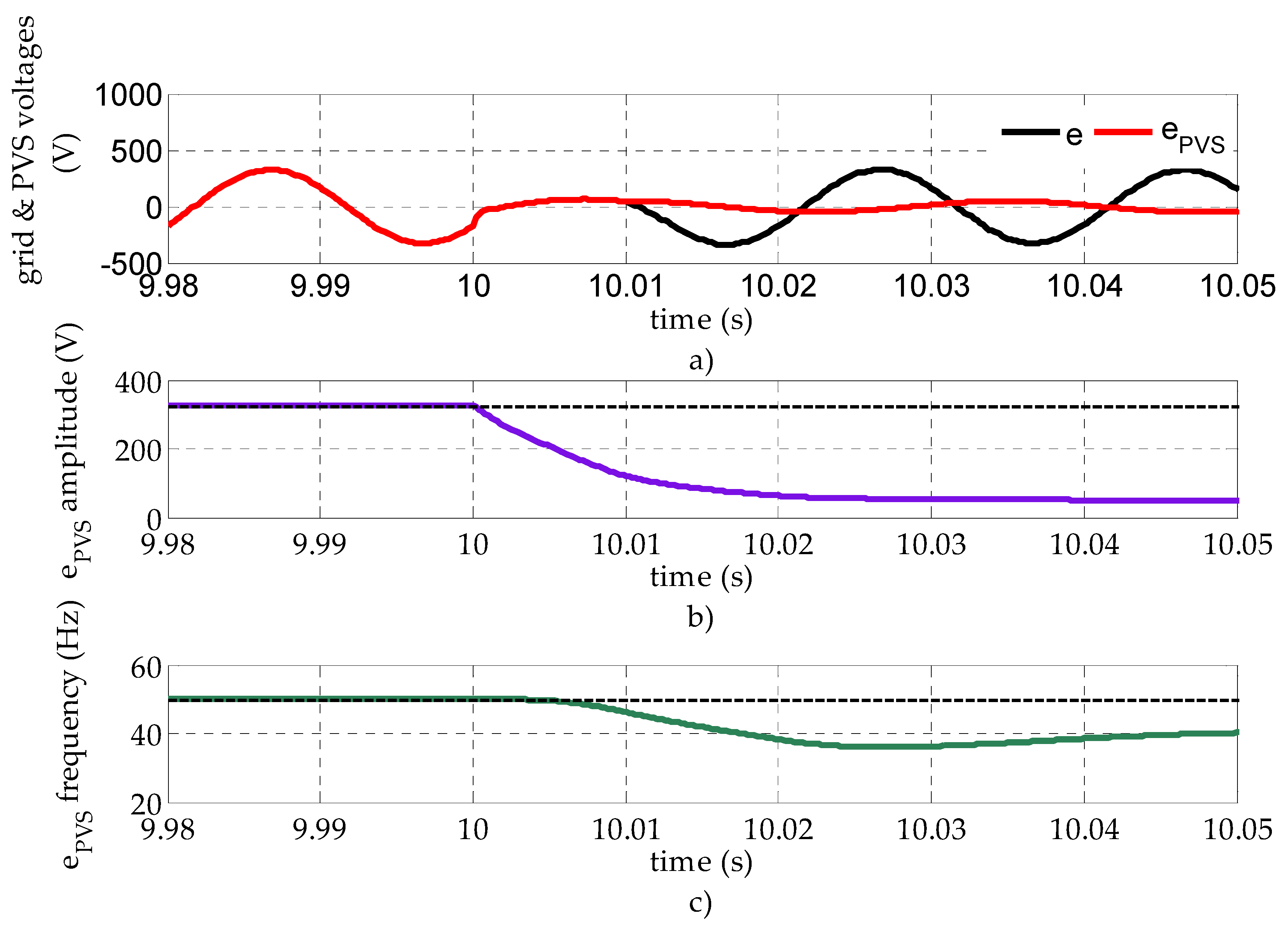
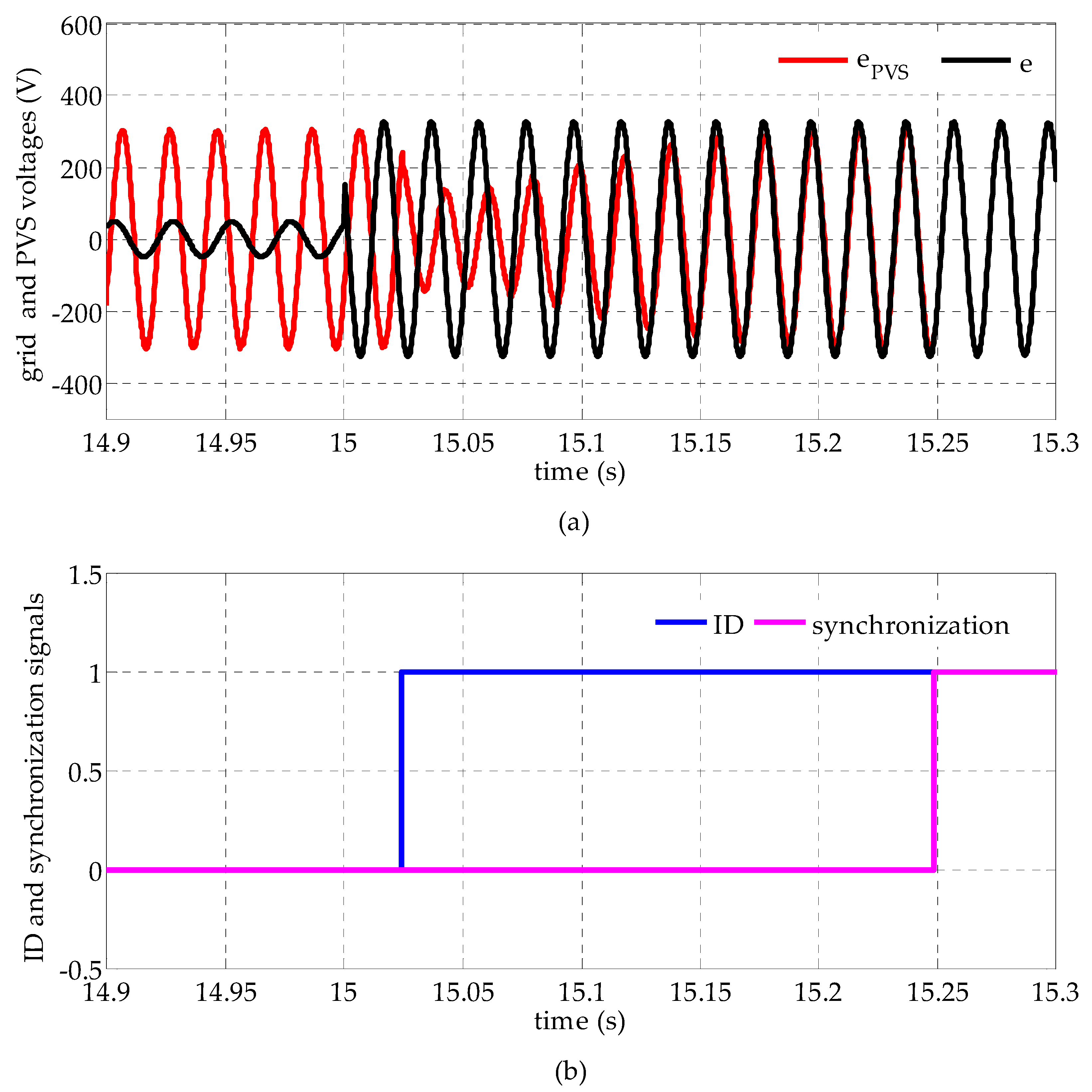
| Communication-Based Methods | Passive Methods | Active Methods | Signal Processing-Based Methods | |
|---|---|---|---|---|
| Accuracy | high | poor | high | high |
| NDZ area | absent | wide | limited | absent or limited |
| Dynamics | fast | generally fast | medium slow | fast |
| Impact on the grid | no | no | medium or significant | no |
| Price | high | limited | limited | high |
| Communication-Based Methods | Passive Methods | Active Methods | Signal Processing-Based Methods | |
|---|---|---|---|---|
| Advantage | reliability | simplicity | accuracy relative simplicity | accuracy |
| Disadvantage | expensive with regard to low power PVSs | erroneous detection in case of power balance between generation and load | power quality detriment | complexity |
| improper estimation due to ride-through requirements compliance | stability hazard in case of numerous PVSs connected in parallel |
| Method | Devices | |
|---|---|---|
| Communication-based | PLCC-based | Receivers |
| SCADA-based | ||
| Passive | OUV/OUF | Solid-state relays or PLLs/EPLLs coordinated with relays |
| ROCOF | ||
| PJ | Additional PLL/EPLL for current monitoring | |
| VHM | Additional PLLS/EPLLS for voltage harmonics monitoring | |
| Active | Grid impedance variation | Impedance measurement |
| Active and reactive power injections | Solid-state relays or PLLs/EPLLs coordinated with relays | |
| AFD | ||
| SFS | ||
| SVS | ||
| SMS | Modified or additional PLL/EPLL | |
| Signal-processing-based | FT-based | Harmonics measurement and localization of electrical time-varying signals |
| WT-based | ||
| ST-based | ||
© 2020 by the author. Licensee MDPI, Basel, Switzerland. This article is an open access article distributed under the terms and conditions of the Creative Commons Attribution (CC BY) license (http://creativecommons.org/licenses/by/4.0/).
Share and Cite
Mastromauro, R.A. Grid Synchronization and Islanding Detection Methods for Single-Stage Photovoltaic Systems. Energies 2020, 13, 3382. https://doi.org/10.3390/en13133382
Mastromauro RA. Grid Synchronization and Islanding Detection Methods for Single-Stage Photovoltaic Systems. Energies. 2020; 13(13):3382. https://doi.org/10.3390/en13133382
Chicago/Turabian StyleMastromauro, Rosa Anna. 2020. "Grid Synchronization and Islanding Detection Methods for Single-Stage Photovoltaic Systems" Energies 13, no. 13: 3382. https://doi.org/10.3390/en13133382
APA StyleMastromauro, R. A. (2020). Grid Synchronization and Islanding Detection Methods for Single-Stage Photovoltaic Systems. Energies, 13(13), 3382. https://doi.org/10.3390/en13133382





